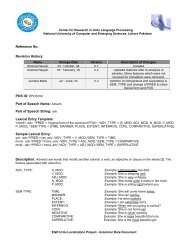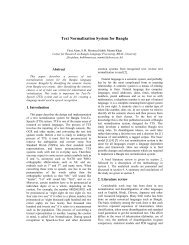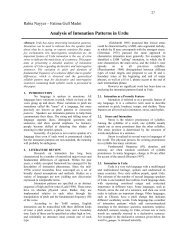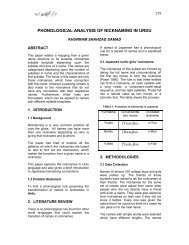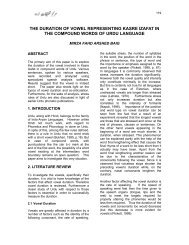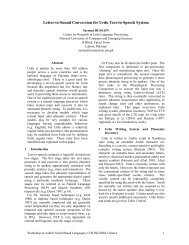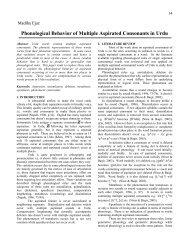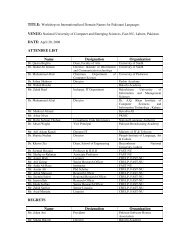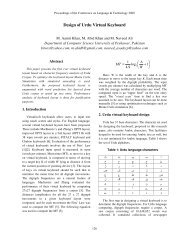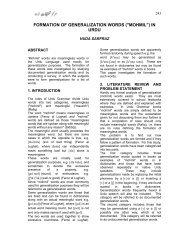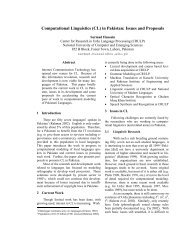Urdu Domain Names - Center for Language Engineering
Urdu Domain Names - Center for Language Engineering
Urdu Domain Names - Center for Language Engineering
You also want an ePaper? Increase the reach of your titles
YUMPU automatically turns print PDFs into web optimized ePapers that Google loves.
B. PunycodeIn order to make the hostname DNS compatible theUnicode string has to be converted to ACE. Many schemeshave been proposed in this regard. Punycode is a bootstringencoding mechanism that uniquely converts Unicodestring to the allowed ASCII based encoding. Thisconversion takes place through an algorithm known asToASCII(). ToUnicode() converts back ASCII basedencoding into Unicode compatible scheme. Punycode usesconventional ASCII i.e. a-z, 0-9 and hyphen, <strong>for</strong> backwardcompatibility [6].The ToASCII function is applied separately to all thelabels in domain name. There is a possibility that thegenerated Punycode is already a registered domain. Forexample, when http://www.ا.com is converted usingToASCII() function, the domain name ا (U+0627) isconverted to ASCII string “mgb” but http://www.mgb.commay already be a registered domain. To avoid significantduplication, all such conversions through the ToASCII()function are appended with a four character prefix “xn--”.The URL http://www.ا.com is there<strong>for</strong>e converted intohttp://www.xn--mgb.com.III. EVALUATION OF DNS AND IDNAApart from political issues, there are also someadditional criticism associated with DNS system generallyand specifically <strong>for</strong> IDNA.Limitation of DNS to encode many languages due to itsASCII base has already been discussed.RFC 920 [9] expanded the addressing convention toinclude top level domains (TLDs) like .edu, .com, .org, etc.However, now these are being used beyond the intendedusage. For example, .com.la was sold by Lao PDR to agroup which is using this TLD <strong>for</strong> Los Angeles city, andTuvalu’s county code .tv is being used by names associatedwith television.It is currently being debated whether IDN should rideover the existing DNS system, as discussed. ICANN argues<strong>for</strong> the importance of a single root. However, there are alsoother parallel namespaces which are successfully working,e.g. <strong>for</strong> companies like AOL and Skype, and <strong>for</strong> countrieslike China Internet Network In<strong>for</strong>mation <strong>Center</strong> (CNNIC),Japan Network In<strong>for</strong>mation <strong>Center</strong> (JPNIC) and KoreaNetwork In<strong>for</strong>mation <strong>Center</strong> (KRNIC), which aremaintaining thousands of addresses. And other domainslike telephone exchanges have shown that parallel systemscan co-exist and effectively communicate with propercollaboration [3].Though a unique Internet Protocol (IP) numberidentifies each address, DNS was introduced <strong>for</strong> the ease ofusers. However, DNS is not always visually unique, whichcan cause malicious or unintentional intervention. Forexample, lower case “L” in English looks similar to theupper case “I” or the digit “1” in some fonts. Thus, thewebsite www.paypal.com may be written in different wayswhich are visually identical. Same is the case with the digit“0” and the upper case letter “O”. This confusion could beeven more profound if additional scripts are incorporated inthe URL to enable multilingual IDN and more phishing [10]attacks are possible [3].A variety of solutions have been considered to controlthe confusion that is caused by the visual similarity within ascript, and enhanced by allowing multilingual domainnames. At least one way to restrict some confusion is todisallow use of characters from different script blocks inUnicode to be used within a domain name. Thus, purelyArabic script domain names may be allowed but domainnames with Arabic letters mixed with Latin characters maynot be allowed. However, some languages do traditionallyuse some letters across scripts (as encoded in Unicode) andthere<strong>for</strong>e some mechanism still needs to allow non-arbitraryand pre-defined mix of characters <strong>for</strong> certain languages.For example, <strong>Urdu</strong> may use digits in Latin block.Moreover, there may be confusion <strong>for</strong> a languagewithin a script block. Unicode being a script based standardgroups all letters across all languages which use the samescript. There also additional variants due to other reasons 2 .Thus, from a single language there may be redundancy. Sobeyond normalization [normalization], which is notlanguage specific, further language dependent mapping mayalso be required.Thus, language specific conventions need to be given<strong>for</strong> controlling which characters may be allowed within andacross scripts <strong>for</strong> a particular language. This may alsodepend on where the language is used (<strong>for</strong> example, samelanguage may be written using a different script in differentregions). So the language specific in<strong>for</strong>mation also needs tospecify the region <strong>for</strong> which the conventions are valid. Thismay be achieved through defining language tables [17].There tables are to be maintained by the registrars ofdomains. The table <strong>for</strong> each language would list the “basecharacters” it allows and their “variant(s).” In addition, itwould also contain letters from other scripts conventionallyused by the language. The language table is labeled withlanguage and regional codes, e.g. those used in localedefinitions [2]. See [16] <strong>for</strong> a template <strong>for</strong> defining alanguage table.Finally, even though Punycode gives a uniquemechanism <strong>for</strong> conversion between ASCII and Unicode, itis still being debated if this conversion will only beapplicable the unique address or also to gTLDs andccTLDs. This has significant political implications as well.IV. URDU DOMAIN NAMESEnabling domain names in <strong>Urdu</strong> also has significantpolitical, social and financial implications. The rest of thispaper discusses the technical challenges related to enabling<strong>Urdu</strong> IDN and proposes a solution. This solution has alsobeen implemented as a concept system <strong>for</strong> testing andfurther improvement.2 For example, <strong>for</strong> backward compatibility.
ًٰA. Character Set<strong>Urdu</strong> character set has been defined and standardized atnational level [12, 13] and within Unicode [14]. In thecharacter set there are different types of characters. Theseinclude basic alphabet, digits, vowel marks, punctuationmarks, honorifics, and special symbols. See [13] <strong>for</strong> details.The first decision which needs to be made is which subset isallowed to be part of <strong>Urdu</strong> domain name. Latin basedURLs allow “LDH” scheme, allowing letters ‘a-z’, digits‘0-9’ and hyphen ‘-’. <strong>Urdu</strong> has more complex writingconventions. At least, all the basic characters and digitsmust be allowed. <strong>Urdu</strong> also optionally uses diacritics,which help in defining the vowels. In normal writing thesevowels are not written. However, they are used todisambiguate homographs (which are spoken in multipleways but only distinguished based on the diacritics used).Also, certain diacritics are not optional and must be used <strong>for</strong>correct spelling, e.g. Khari Zabar (e.g. (ا and Do-Zabar(e.g. ). If diacritics are allowed in the URLs, it wouldnot be clear what would be the URL if the optionaldiacritics are not used. <strong>Urdu</strong> speakers would generallyconsider URLs with and without the optional diacriticsequivalent. Thus, these optional diacritics are not required.However, non-optional diacritics would be expected by the<strong>Urdu</strong> readers, e.g. <strong>for</strong> the words give earlier. Study of a 12million word corpus 3 of <strong>Urdu</strong> show that about 710 wordswith these required diacritics have occurred a total of24,293 times. Generally, in this corpus optional diacriticswere used 41,332 times showing a very small percent ofwords are typed with diacritics. This data shows that theuse of diacritics may not be necessary. Additionally, thedata shows that <strong>for</strong> the required diacritics, significant timesthe diacritic(s) are not placed consistently at the same place,e.g. ی الہ (found 11, 50 and 549 times in thecorpus respectively). Thus, if they are allowed, it mayintroduce another way of phishing.Most of the pronunciation marks are not necessary <strong>for</strong>URL and may be excluded. However, <strong>Urdu</strong> end of sentencemarker ’۔‘ is needed to separate the domain name, gTLDand ccTLD. This has two associated issues. First, should itbe synonymously used with the Latin period ‘.’? Secondissue is that this end of sentence marker <strong>for</strong> <strong>Urdu</strong> is ahomograph of hyphen, which is allowed in URLs but doesnot act as a separator between domain names, gTLDs andccTLDs. Thus, it would become very confusing <strong>for</strong> the userwhen period, hypen and end of sentence marker <strong>for</strong> <strong>Urdu</strong>are mixed, but would be entirely possible <strong>for</strong> multilingualdomain names. An added problem may occur when theperiod is mixed with <strong>Urdu</strong> digit zero, which is almost ahomograph. “.- ٠ ”۔ shows a Period-Hypen-<strong>Urdu</strong>Zero-<strong>Urdu</strong>EndOfSentenceMarker sequence. A solution is not toالٰہ and الہٰ ی , یٰallow hyphen in <strong>Urdu</strong> domain names and allow <strong>Urdu</strong> end-ofsentence marker to be used synonymously with ‘.’ as tagseparators within a domain name.Honorifics are optional in most cases, or have a regular(longer character based phrasal equivalent). For Muslims, itis recommended to put “ ” symbol or the equivalent “£”ligature 4 with the name of Prophet Muhammad. If it isdisallowed in the domain name, then any website whichuses this address would need to have the fully expanded<strong>for</strong>m, which may be very long and difficult <strong>for</strong> users to typeout. Two other honorifics like ‘ ’, ‘ ’ are also mandatorywhen mentioning names of Companions of ProphetMuhammad and other prophets respectively. Otherhonorifics are optional. These honorifics have been used292 times in the 12 million word <strong>Urdu</strong> corpus. It isrecommended to allow required honorifics as the variant<strong>for</strong>ms, which can be de-normalized as given in Table 3 inAppendix B. Others optional honorifics e.g. ‘ ’ and‘ ’may be disallowed.Other symbols are mostly notational (e.g. footnotemarker, sign to indicate a verse quoted in prose, etc.).These are not necessary <strong>for</strong> inclusion in the domain names.B. CursivenessArabic writing system is highly cursive, with mostletters having at least four shapes, when they occur in thebeginning, middle, and end of a sequence and in isolation.There are two kinds of letters, one set which can join withothers, and another set of letters which cannot join withletters after them. As domain names do not allow the spacecharacter within them, if multiple words of <strong>Urdu</strong> arewritten, they would join together and may be mis-read. InEnglish, words can be separated by hypen or using a capitalletter, e.g. “two-words” and “TwoWords” so space is notrequired. However, <strong>Urdu</strong> neither has a hyphen nor capitalletters. It is possible to insert a zero-width-non-joiner(ZWNJ, U+200C) but this character is not familiar <strong>for</strong> users.The second option is to allow <strong>for</strong> the space character by theusers <strong>for</strong> proper visual rendering of multiple words. Thespace may be removed in the nameprep or other process atclient side or at the registrar, so that the final Unicodeoutput would not include it. Similar treatment may be donewith ZWNJ. However, this will allow the user to view thedomain name correctly.C. EncodingMinimally <strong>Urdu</strong> Zabta Takhti [13], UTF-8 and Unicodesupport must be provided. There are also other nonstandardencodings but should remain out of scope of thisprocess.3 This unpublished corpus is balanced over different genresand is derived from online material published after 1996.4 This symbol stands <strong>for</strong> the phrase “peace be upon him.” Athird variation is to actually spell out the whole phrase.
D. NormalizationThere is a lot of redundancy in Unicode <strong>for</strong> Arabicscript. Arabic block is from U+0600 till U+06FF andextended Arabic from U+0750 to U+077F. In addition, <strong>for</strong>backward compatibility, actual position based glyphs havealso been included from U+FB50 till U+FDC7 and U+FE70till U+FEFF. Finally, special symbols are listed atU+FDFx.Three kinds of normalization are required. First, thereare characters within the Unicode which are repeated <strong>for</strong>different languages allowing redundancy. This redundancymust be removed to allow unique naming space. Forexample, there are two sets of digits, one <strong>for</strong> Arabic andother <strong>for</strong> remaining languages (e.g. Farsi, <strong>Urdu</strong>, Sindhi,etc.). However, though the following are written usingthese two different sets of Unicode values, ١٢٣ and ١٢٣ arevisually same. A complete list of potentially confusingcharacters from the perspective of <strong>Urdu</strong> and theirrecommended equivalents <strong>for</strong> normalization are given inAppendix B. In addition, all the Arabic Presentation Formsshould also be mapped onto the base <strong>for</strong>ms within U+06xx.However, not all characters are easily possible to map.Some characters do not share the same behavior but are stillconfusing and may be used naïvely or maliciously. Thusthe normalization process needs to be extended beyond thepermitted canonical limits proposed by Unicode to preventthese possibilities. Thus, all types of Yay, Hay, etc. arenormalized. It is also important to note that thesenormalizations would not work across other languages (e.g.Sindhi, Pashto, etc.) and are only done in context of <strong>Urdu</strong>.Thus, these must be included in the language table at theregistrar, as proposed by [17]. The “base characters” aregiven in Appendix A and the one’s that have variants arelisted in Table 1 in Appendix B.Second, when base letters combine with somecombining characters, their equivalent is also encodeddirectly in Unicode. Thus, آ can be written as U+0622 or acombination of U+0627 and U+0653. However, thesesequences should be normalized. This normalization is alsogiven in Table 2 in Appendix B and is part of the nameprepprocess.Finally, Unicode also lists many ligatures. Theseligatures must be de-normalized into base characters aswell. A list of ligatures and their character equivalents isalso given in Table 3 in Appendix B. These must also bedone in the nameprep procedure.E. Writing StyleThough Naskh style of writing is acceptable, <strong>Urdu</strong>language speakers prefer Nastalique style of writing[hussain3]. This is a font issue and though it hasimplications on the client side graphical user interface, ithas no implication on IDN or nameprep function.F. gTLDs<strong>Urdu</strong> would eventually need its own gTLD set andseparate name space. However, along with that it shouldalso be possible to access existing namespaces in <strong>Urdu</strong>using direct mapping. Latter is already possible, ifincorporated at the client side during nameprep processing.A set of gTLDs and their translation are listed in AppendixC which may be used <strong>for</strong> such mapping.G. ccTLDsSimilar to gTLDs, ccTLDs also need to be translated.However, they would share the same namespace and mustbe mapped onto existing ccTLDs at the client side.However, <strong>Urdu</strong> translation is still required <strong>for</strong> the <strong>Urdu</strong>users. The mapping is given in Appendix D.G. Conversion of wwwAs <strong>for</strong> the regular URLs, <strong>Urdu</strong> address would also needto specify the name space. The first portion of the stringnormally specifies www. This could be transliterated into<strong>Urdu</strong> as ووو to represent the same space. However, it wouldneed to be transliterated to www at the client side <strong>for</strong> furtherprocessing.V. URDU DOMAIN NAME ALGORITHMA solution <strong>for</strong> <strong>Urdu</strong> domain names would have thefollowing steps:1. Use the separator and divide the URL into differentportions2. Convert ووو to www3. Remove Diacritics, honorifics and any specialsymbols from the domain address, except thehonorific used <strong>for</strong> Prophet Muhammad and otherProphets and messengers4. Remove space or ZWNJ markers from the domainaddress5. Normalize the resulting domain address using therules discussed above6. Use ToASCII() function to generate the Punycodeequivalent string7. Check if the Punycode is from valid charactersusing the language tables at the registry, aftervariant characters are mapped onto the basecharacters8. Find English mapping of the <strong>Urdu</strong> gTLD9. Find English mapping of the <strong>Urdu</strong> ccTLD10. Keep any trailing string unchanged11. Concatenate the strings from 2, 6, 7, 8 and 9 to<strong>for</strong>m the corresponding English URL12. Forward the address as an http requestSteps 8 and 9 is currently doing simple mapping from<strong>Urdu</strong> to English equivalents. However, if local languagegTLDs are also enabled, then Punycode conversion wouldbe required at this step instead of mapping.
This procedure converts the <strong>Urdu</strong> domain namea ووو۔اردو۔ into www.xn--mgbgjgj9ha8b83g.net 5 , anddoes not allow spurious domain names, to avoid confusion.The procedure is as per the ICANN guidelines [18].VI. ISSUES AND FUTURE CONSIDERATIONSSpoofing [11] and Phishing [10] attacks are one of themajor concerns <strong>for</strong> IDNA. As discussed, people can usehomoglyphs (or visually similar characters) to developalternate websites which look similar to target websites.These spoofed websites can then phish <strong>for</strong> users to acquireprivate in<strong>for</strong>mation of the users (e.g. credit card in<strong>for</strong>mationetc.). Like other languages, <strong>Urdu</strong> IDNA system will also beopen to such attacks. The extended normalization processsuggested above has been devised to rebuff suchpossibilities. However, there are still other ways to spoofusing other language characters. Thus such possibilitycannot be totally controlled. Other mechanisms need to bedeveloped <strong>for</strong> better control, e.g. security certificates, filters,etc. A complete discussion is beyond the scope of the paper.However, see [10, 11] <strong>for</strong> further details.Even after normalization, it is also possible to “spoof”using legitimate means due to spelling variations and othermethods. Thus, www.color.com, www.colour.com,www.color.net are all possible spoofing possibilities <strong>for</strong>www.colour.net. Similar possibilities also exist in <strong>Urdu</strong>.For example, ووو۔زت۔a may be confused witheven though the two are legitimately different based onencoding and confusion occurs based on how <strong>Urdu</strong> usesthese characters.However, technical and security constraints cannotundermine the immense potential and requirement oflocalized domain names. It is necessary <strong>for</strong> bridging thedigital divide and give access to the universe of onlinecontent to local populations. Both public and privateorganizations need to strive to provide a secure butuniversal access to cyberspace [unesco].ACKNOWLEDGEMENTSووو۔زة ۔This work carried out with the aid of a grant fromInternational Development Research <strong>Center</strong> (IDRC),Ottawa, Canada, administered through the <strong>Center</strong> <strong>for</strong>Research in <strong>Urdu</strong> <strong>Language</strong> Processing (CRULP), NationalUniversity of Computer and Emerging Sciences (NUCES),Pakistan. The authors would also like to acknowledge thesupport of researchers at CRULP <strong>for</strong> providing data andvaluable feedback on the paper.REFERENCES[1] Unicode Consortium, Unicode 5.0, 5th ed., Addison-Wesley Professional, 2006.[2] Unicode Consortium, “Common Locale Data RepositoryProject,” http://www.unicode.org/press/pr-cldr1.4.html[3] D. Butt, “Internationalized <strong>Domain</strong> <strong>Names</strong>,”http://www.apdip.net /apdipenote/9.pdf, APDIP.net, 2006.[4] P. Faltstrom, P. Hoffman, and A. Costello,“Internationalizing <strong>Domain</strong> <strong>Names</strong> in Applications(IDNA),” http://www.rfc-editor.org/rfc/rfc3490.txt, 2003.[5] P. Hoffman,M. B. Viagenie, "Nameprep: A StringprepProfile <strong>for</strong> Internationalized <strong>Domain</strong> <strong>Names</strong> (IDN)”http://www.rfc-editor.org/rfc/rfc3491.txt, 2003.[6] A. Costello, “Punycode: A Bootstring encoding ofUnicode <strong>for</strong> Internationalized <strong>Domain</strong> <strong>Names</strong> inApplications (IDNA),” http://www.rfc-editor.org/rfc/rfc3492.txt, 2003.[7] M. Davis, M. Durst, “Unicode Normalization Forms,”http://www.unicode.org/reports/tr15/, 2005.[8] P. Hoffman and M. B. Viagenie, “Preparation ofInternationalized Strings ("stringprep"),” http://tools.ietf.org/html/rfc3454, 2002.[9] J. Postel, J. Reynolds, “<strong>Domain</strong> Requirements,”http://www.rfc-editor.org/rfc/rfc920.txt, 1984.[10] Wikipedia, “Phishing,” http://en.wikipedia.org/wiki/Phishing.[11] Wikipedia, “Spoofing Attack,” http://en.wikipedia.org/wiki/ Spoofing_attack.[12] M. Afzal and S. Hussain, “<strong>Urdu</strong> Computing Standards:Development of UZT 1.01,” in Proceedings of the IEEEInternational Multi-Topic Conference, Lahore, 2001.[13] . S. Hussain and M. Afzal, “<strong>Urdu</strong> ComputingStandards: UZT 1.01,” in Proceedings of the IEEEInternational Multi-Topic Conference, Lahore, 2001.[14] S. Hussain & K. Zia, “Proposal to Add Marks andDigits in Arabic Code Block (<strong>for</strong> <strong>Urdu</strong>),” in Proceeding of42nd Meeting of ISO/IEC JTC1/SC2/WG2, Dublin, Ireland,2002.[15] S. Hussain, “Complexity of Asian Scripts: A CaseStudy of Nafees Nasta’leeq,” in the Proceedings ofSCALLA, Kathmandu, Nepal, 2004.[16] http://www.iana.org/assignments/idn/registry-language-template.txt[17] J. Klensin, “Suggested Practices <strong>for</strong> Registration ofInternationalized <strong>Domain</strong> <strong>Names</strong> (IDN),” http://www.rfceditor.org/rfc/rfc4290.txt,2005.[18] “Guidelines <strong>for</strong> Implementation of Internationalized<strong>Domain</strong> <strong>Names</strong>,” http://www.icann.org/general/idnguidelines-22feb06.htm,2006.5 The conversion has been done from the sitehttp://www.panl10n.net/Puny/udnc.php. Also seehttp://mct.verisign-grs.com/index.shtml <strong>for</strong> similar purpose,though latter is not completely functional <strong>for</strong> <strong>Urdu</strong>.
APPENDIX A: BASE CHARACTER SETGlyph Unicode Glyph Unicodeز0632ےس063306D306C2٠06F0ش0634APPENDIX B: LETTER NORMALIZATION FOR URDUا06F1ص0635Table 1: Letter normalization <strong>for</strong> <strong>Urdu</strong>٢06F2ض0636Variant FormRecommended Base Form٣06F3ط0637١ (661) ١(6f1)۴06F4ظ0638٢(662) ٢(6f2)۵06F5ع0639٣(663) ٣(6f3)٦۷۸٩06F606F706F806F9062706220628067E062A0679062B062C0686غفقكگلمنںوہھةاآبپتٹثجچ063A0641064206A906AF06440645064606BA064806C106BE06C3٤(664) ۴(6f4)٥(665) ۵(6f5)٦(666) ۶(6f6)٧(667) ٧(6f7)٨(668) ٨(6f8)٩(669)٩(6f9)٠(660) ٠(6f0)6A9) ( ک (643) ك(6CC)ی(649)ى(649)ى(629) ة(64A)ي(6C3) ةTable 2: Case fold normalization <strong>for</strong> <strong>Urdu</strong>CharactersNormalizedFormRecommendedFormئىےحخدڈ062D062E062F0688062106CC06D2ٔ 0623 اآٔ اآٔ اؤےؤےذر06300631ؤے062406D4ئئڑ0691ئ0626
Table 3: Ligature normalization <strong>for</strong> <strong>Urdu</strong>Ligature FormلاRecommended Formا+لہ+ل+ ل + اد+م+ح+مااللهمحمدر+ب+ك+ا اòم+ع+ل+صل+و+س+ررل ہ+ى+ل+عم+ل+س+ووò﷽£ى+ل+ص+م+ ح + ا ر+ہ+ ل + ل+ ا+ م+ س+ب+ى م+ ح + ر+ ا+ن+ہ+ى+ل+ع+ہ+ل+ل+ا+ى+ل+صم+ل+س+و+ہ+ى+ل+ع+ہ+ل+ل+ا+ى+ل+صم+ل+س+وہ+ل+ا+ل+ج+ل+جAPPENDIX C: URDU TRANSLATIONS FOR GTLDEnglish gTLDAbbr.of <strong>Urdu</strong> gTLDgTLDAPRA apra ا COMPANY com öات INFORMATION infoMEDIA media NAME name مBUSINESS biz و ر رAEROSPACE aero ت PROFESSIONAL pro وõCOOPERATIVE coop ا MUSEUMmuseum ز Employment Related jobs لازTravel Agents,Airlinestravelð Asian Community asia ا Mobile Devices mob Telephone networkand Internettel اòلاتڈاك Postal Service postGovernment of SindhGovernment ofPunjabGovernment ofNWFPGovernment of AzadKashmirGovernment ofBaluchistanGOS.PKGOP.PKGON.PKGOK.PKGOB.PKð ھð ب ð ð öðن ðو Web Sites Web Family andIndividualsfam انAPPENDIX D: TRANSLATIONS FOR CCTLD’SEDUCATION edu GOVERNMENT gov ðMILITARY mil جادارہ ORGANIZATION orgINTERNATIONAL int NET net English ccTLDAfghanistanAlbaniaAlgeriaAbbr.<strong>for</strong> cc-TLDafaldz<strong>Urdu</strong> ccTLDانا ا
لآAmerican SamoaAndorraasadا آ اوڑاBruneiBulgariabnbg و ر Angolaao الاBurkina Fasobf õ Anguillaai ااBurundibiو ىAntarcticaAntigua andBarbudaArgentinaArmeniaArubaAustraliaaqagaramawauار ا ا ا رڈا ر ðآر ار و ااCambodiaCameroonCanadaCape VerdeCayman IslandsCentral AfricanRepublickhcmcacvkycf ڈ öون ا ورڈے اð وù اõ AustriaAzerbaijanBahamasBahrainatazbsbhنآ آزر س ChadChileChinaChristmas Islandtdclcncxڈ ð آ öBangladeshBarbadosBelarusBelgiumBelizeBeninBermudaBhutanBoliviaBosnia andHerzegovinaBotswanabdbbbybebzbjbmbtbobabw د دوس ر لارس ن ا Cocos (Keeling)IslandsColombiaComorosCongoCook IslandsCosta RicaCote d'IvoireCroatiaCubaCyprusCzech Republiccccokmcdckcrcihrcucyczاð ز روس آ ز رآ رى وö ص ð ð رBouvet IslandBrazilbvbr آئ از Denmarkdk ڈرك
َِٓDjiboutidj ðGreenlandgl Dominicadoڈو Grenadagdڈا East Timortpر Guadeloupegpاڈى ¯پEcuadorEgyptecegا اڈور GuamGuatemalagugtاملا El SalvadorEquatorialGuineaEritreasvgqerا اڈور ا ا ا GuernseyGuineaGuinea-Bissaugggngw ؤ Estoniaeeآ GuyanagyآEthiopiaetا Haitiht Falkland IslandsFaroe IslandsFijiFinlandfkfofjfiكõاð اð و õ õ õHeard Island andMcDonaldIslandsHoly See(Vatican City)Hondurashmvahnو وراسFranceFrench GuianaFrench PolynesiaFrench Southernand AntarcticLandsGabonGambiaGaza StripGeorgiaGermanyGhanaGibraltarGreecefrgfpftfgagmgedeghgigrاõ õ õ ð ِاõن â رð ððا ن Hong KongHungaryIcelandIndiaIndonesiaIranIraqIrelandIsraelItalyJamaicaJan Mayenhkhuisinidiriqieilitjmsj ىآ ا او ا ان Ùاقا اا ا ð ن
تJapanJerseyJohnston Atolljpjeآلن ðMaltaMarshall IslandsMartiniquemtmhmq آ ر رJordanjoاردنMauritaniamr رKazakhstanKenyaKiribatiKzkekiزن öMauritiusMayotteMexicomuytmx ر او North Koreakp ر â Micronesiafm و South KoreaKuwaitKyrgyzstanLaosLatviakrkwkglalv ر ð öنلاؤس MoldovaMonacoMongoliaMontserratMoroccomdmcmnmsmaوا وöاLebanonlbن Mozambiquemz زLesothols Namibiana Liberialr لا NaurunrؤروLibyaly Nepalnpل LiechtensteinliNetherlandsanر ز ِLithuaniaLuxembourgltlu آ گ New CaledoniaNew Zealandncnz ڈو زى MacauMacedoniamacaumkؤ ڈو َNicaraguaNigernineراا Madagascarmg و Nigeriang MalawiMalaysiaMaldivesMalimwmymvmlلاو ى لا âNiueNorfolk IslandNorthern MarianaIslandsNorwaynunfmpno آ رك â آ ز روے
ىOmanPakistanPalauPanamaPapua NewGuineaParaguayPeruompkpwpapgpypeاونöن اð لاؤ ا ا و PrincipeSaudi ArabiaSenegalSeychellesSierra LeoneSingaporeSlovakiasasnscslsgskدى Ùبل ا ن ر اPhilippinesph õSloveniasi و Pitcairn Islandspnاð ن Solomon Islandssbاð ¯ن Polandpl Somaliaso PortugalptلSouth Africaza اõ ðPuerto RicoQatarReunionRomaniaRussiaRwandaSaint HelenaSaint Kitts andNevisSaint LuciaSaint Pierre andMiquelonSaint Vincent andtheGrenadinesSamoaSan MarinoSao Tome andprqarerorurwshknlcpmvcwssmst رر رى رو روسرواا ا ¯ اى و ا ڈا آ نؤ م ا South Georgiaand theSouth SandwichIslandsSouthern OceanSpainSri LankaSudanSurinameSwazilandSwedenSwitzerlandSyriaTajikistanTanzaniaThailandTogoTokelaugseslksdsrszsechsytjtzthtgtk ا ؤ رð آ وچ ؤز ð ڈانم ازىن ر من ð ا لاؤ
TongaTrinidad andTobagoTunisiaTurkeytotttntr ادا MyanmarPalestinian State(proposed)mmpsر ر õ(زہ (TurkmenistantmöنTurks and CaicosIslandstcاð اورؤس كTuvaluUgandatvug¯اا Ukraineuaاö United ArabEmiratesUnited Kingdomaeukgbہ Ùب ارات ہ United Statesusا UruguayUzbekistanuyuzرو ز ن اVanuatuVenezuelaVietnamVirgin IslandsWallis andFutunavuvevnvgwfوواآلا و وم ور ð آ ز و ا õ آ ز Western Saharaehòرا Yemenye Zambiazmز Zimbabwezw زےTaiwanEuropean Uniontweuان ر



